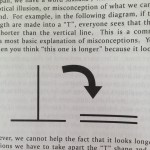Lean thinking is about changing your story about work – it’s never content free
“Apply a dose of lean every day and your results will improve” or “if it doesn’t work, apply double dose (read: you’re not committed enough)!” Does it sound like snake oil? It should.
Lean is not an organizing method. It’s a way of honing your skills to gain competitive edge. Lean doesn’t exist in absolutes – it only makes sense as applied to a business context, a concrete situation. In lean terms… a gemba.
Taiichi Ohno’s original insight was that our misconceptions (wrong ideas about how the world works) reduce our efficiency, which he illustrates by the following visual illusion:

His advice was to root out our misconceptions by:
- Confirming failure with our own eyes
- Be wary of misconceptions hidden in common sense
- Find the blind spots in calculations
All excellent advice. But misconceptions don’t mean we’re wrong about everything – simply that misunderstanding one aspect of the situation can lead us to sub-optimal conclusions.
To find the full power of lean, you first have to be clear about the story you tell yourself about your business and the work you do. For instance, one service provider told itself the story that its corporate customers were pushing prices down very hard, and its senior management required a larger profit – or else. As a result, this company learned to charge every single piece of additional work asked of it, creating, without realizing it, distrust and adversarial relationships.
Practicing the lean tools of listening to every customer complaint and finding out the cause of rework, the company changed the story. It learned to do small, inexpensive things for clients to foster goodwill, and to reduce costs by eliminating the waste of rework and dealing with complaints and bad feelings. As a result it saw its sales revenue increase – more profitably, whilst rebuilding trust with its key customers – who then recommended it to others.
That was a different story. They changed their earlier story into a better one:
- Old Story: our business is very tough, we have to accept rock bottom prices from large customers and we recoup the low price by charging for every extra thing they ask, regardless of relationships
- New story: we look for customers that value working well over lowest price, and we respond quickly to demands, without charging for low cost work, recouping our margin from eliminating waste in our own processes.
But to do this, they had to want to find out their earlier story and seek to discover a new one. Simply applying the lean tools blindly in the hope that you will discover better ways to work won’t make it happen. What will happen, on the other hand, is that people will create a bureaucracy to apply lean tools – it’s easy to look at the finger rather than the moon it points at.
Lean thinking never occurs out of context. Lean thinking happens at the gemba when you look at what you’re doing and think:
- What are we doing here step by step?
- How does this impact customers?
- Where do people struggle to get the job done?
- How could we accelerate the flow?
- What would be a better way (of satisfying customers and making work easier)?
The more you already understand your own work and your business, the ins and outs of your product or service, the more powerful lean thinking becomes. Lean thinking for lean thinking’s sake is likely to generate a lot of debates, but deliver precious few results. And certainly not transform the company. You can’t learn to cook without having an opinion of how yum or yuck dishes taste!
To transform, you’ve got to clarify transform what from what to what: clarify what your current story is, seek the misconceptions in your current views and explore a new, better fit-to-fact story, to gain a competitive edge.









